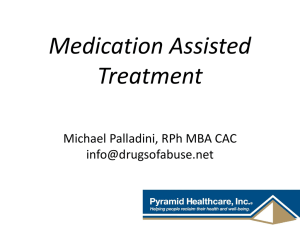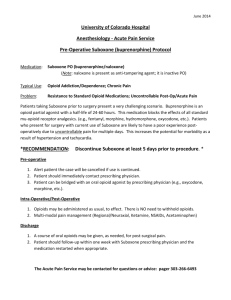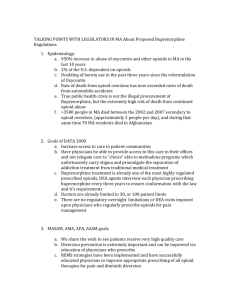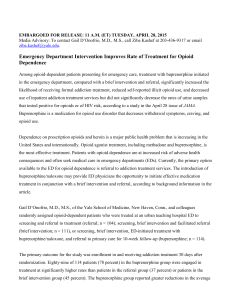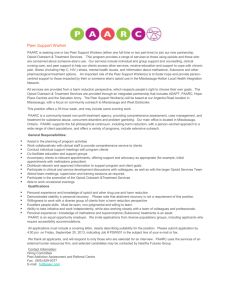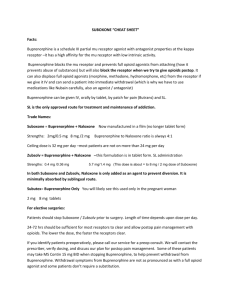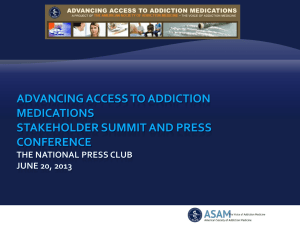Full Resource - PCSS-MAT
advertisement
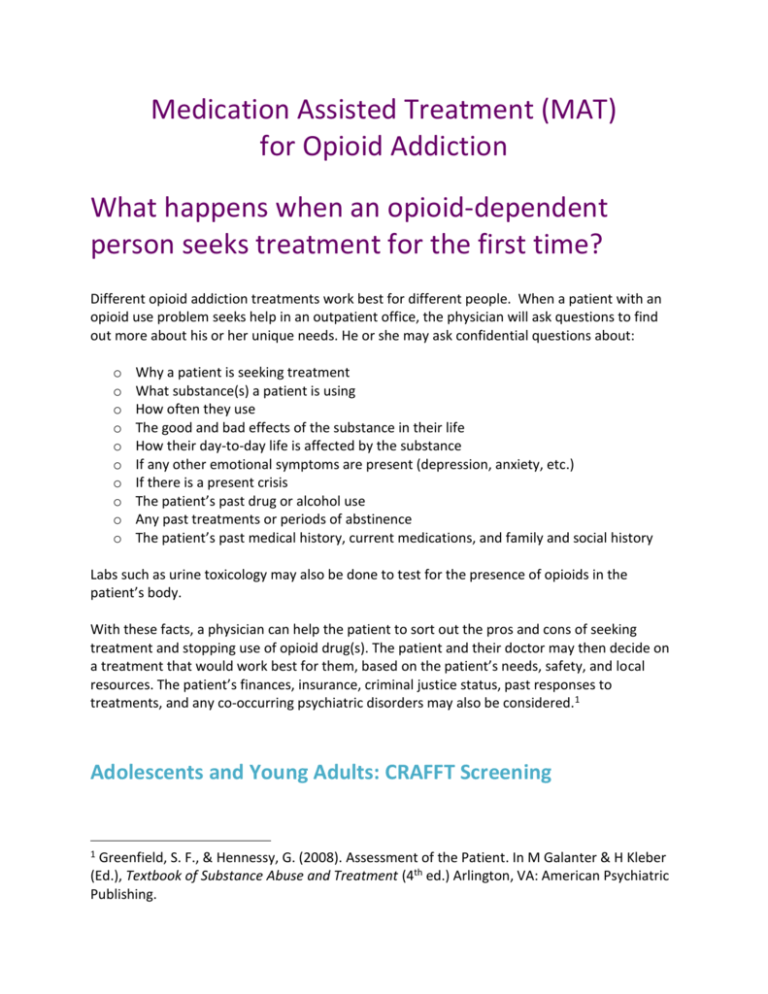
Medication Assisted Treatment (MAT) for Opioid Addiction What happens when an opioid-dependent person seeks treatment for the first time? Different opioid addiction treatments work best for different people. When a patient with an opioid use problem seeks help in an outpatient office, the physician will ask questions to find out more about his or her unique needs. He or she may ask confidential questions about: o o o o o o o o o o Why a patient is seeking treatment What substance(s) a patient is using How often they use The good and bad effects of the substance in their life How their day-to-day life is affected by the substance If any other emotional symptoms are present (depression, anxiety, etc.) If there is a present crisis The patient’s past drug or alcohol use Any past treatments or periods of abstinence The patient’s past medical history, current medications, and family and social history Labs such as urine toxicology may also be done to test for the presence of opioids in the patient’s body. With these facts, a physician can help the patient to sort out the pros and cons of seeking treatment and stopping use of opioid drug(s). The patient and their doctor may then decide on a treatment that would work best for them, based on the patient’s needs, safety, and local resources. The patient’s finances, insurance, criminal justice status, past responses to treatments, and any co-occurring psychiatric disorders may also be considered.1 Adolescents and Young Adults: CRAFFT Screening 1 Greenfield, S. F., & Hennessy, G. (2008). Assessment of the Patient. In M Galanter & H Kleber (Ed.), Textbook of Substance Abuse and Treatment (4th ed.) Arlington, VA: American Psychiatric Publishing. When an adolescent or young adult visits his or her doctor, the CRAFFT questions can help evaluate the risk for substance abuse problems.2 These questions are used all over the world, and are very effective at evaluating a young person’s risk of problems with substance abuse.3 The CRAFFT questions can also be used at home by a young person or the family to help evaluate risk or to decide if medical help is needed. PART 1 During the past year, did you: 1. Drink any alcohol (more than a few sips)? 2. Smoke any marijuana or hashish? 3. Use anything else to get high? (“Anything else” includes illegal drugs, over-thecounter or prescription medicines, or anything that you sniff or “huff.”) PART 2 If the answer is “yes” to any of the first 3 questions, the following questions are used: (If the answer is “no” to all of the first 3 questions, only the first CAR question will apply.) Yes/No C Have you ever ridden in a CAR driven by someone (including yourself) who was “high,” or had been using alcohol or other drugs? Yes/No R Do you ever use alcohol or other drugs to RELAX, feel better about yourself, or fit in? Yes/No A Do you ever use alcohol or other drugs while you are ALONE? Yes/No F Do you ever FORGET things you did while using alcohol or drugs? Yes/No F Do your FAMILY or FRIENDS ever tell you that you should cut down on drinking or drug use? Yes/No T Have you ever gotten into TROUBLE while you were using alcohol or drugs? What does my CRAFFT score mean? 2 The CRAFFT Screening Tool. (2009). Retrieved July 8, 2014, from http://www.ceasarboston.org/CRAFFT/index.php 3 Pilowsky, D. J., & Wu, L. T. (2013). Screening instruments for substance use and brief interventions targeting adolescents in primary care: a literature review. Addict Behav. May 38(5), 2146-53. 2 or more "yes" answers to the CRAFFT questions suggest that a young person is at high risk for substance abuse problems and/ or dangerous behavior. A young person who can answer “yes” to 2 or more CRAFFT questions should seek medical help as soon as possible. If the young person is already at a doctor’s office, further questions should be asked to see if treatment is necessary. These questions cannot diagnose a substance abuse disorder, but can help patients and doctors decide if further steps should be taken. Adults: CAGE Questions The CAGE questions are often used to screen for alcohol abuse in adults. However, they can also help identify other substance abuse problems.4 These questions include: C Have you ever felt you needed to CUT DOWN on substance use? A Have people ANNOYED you by criticizing your substance use? G Have you ever felt GUILTY about substance use? E Have you ever felt that you needed a drug first thing in the morning (EYE-OPENER)? Other “red flags” that primary care doctor look for to detect substance abuse problems in adults include:5 Frequent absences from school or work Frequent accidental injuries Depression Anxiety Sleep problems Sexual dysfunction Digestive problems, like stomach pain, diarrhea, constipation, or weight changes Urine Drug Tests There are many different ways to test for the presence of opioid drugs in the body. Urine, blood, hair, saliva, sweat, and nails (toenails and fingernails) can all be used in different types of laboratory drug testing. However, urine samples are used most often, because they are easier to obtain. Opioid drugs and their metabolites, or breakdown products, are often concentrated in the urine after making their way through the body. 4 Mersy, D. J. (2003). Recognition of Alcohol and Substance Abuse. Am Fam Physician. Apr 1;67(7), 1529-1532. 5 Mersy, 2003. A general “screening” test can test for the presence of opioid drugs or their metabolites (the substances into which some drugs are broken down in the body). More specific tests can also be done to test for the presence of specific drugs or to confirm the results of earlier tests. What can doctors tell from a urine drug test? A urine sample can be tested for the presence of many different substances in the body, from opioid drugs to marijuana, cocaine, PCP, amphetamines, and/or benzodiazepines. Drugs can usually be detected in a urine sample within 1-2 days of use. However, detection times vary widely among different substances. For example, evidence of heroin use can be found in the urine up to 48 hours after last use, and evidence of methadone can be found for 3 days. Longterm marijuana use can be detected for up to 30 days. 6 Urine drug tests can tell doctors that a person has used a substance within a certain time period. Urine drug tests cannot tell doctors how much of a substance a person has used, or how they used it (inhaled, injected, or taken by mouth.) False positive tests can occur. Since some opioids are either derived from or similar to naturally occurring substances in the opium poppy seed, eating poppy-seed cookies or bagels prior to testing has caused false-positive results only in very sensitive tests. The use of prescription opioid pain relievers or certain antibiotics like rifampin, rifampicin, or quinolones can also cause false-positive urine tests for opioids. These possibilities should be discussed with a physician prior to testing. Benefits of Frequent Urine Drug Testing During an initial assessment and periodically throughout treatment, patients may be asked to provide a urine sample in the clinic. Patients are always encouraged to truthfully relate any drug use or relapse to their doctors before this sample is tested. Clinics require urine testing to provide accountability to patients. Frequent testing has been shown to improve a patient’s chances of sticking with treatment.7 Drug testing is also helpful to keep patients safe: some addiction treatments like methadone and buprenorphine can be very dangerous when taken along with other drugs. If patients have relapsed to additional illicit drug use while using MAT, physicians need to know. 6 Moeller, K. E., Lee, K. C., & Kissack, J. C. (2008). Urine drug screening: practical guide for clinicians. Mayo Clin Proc., Jan 83(1), 66-76. 7 Yee, D. A., Hughes, M. M., Guo, A. Y., Barakat, N. H., Tse, S. A., Ma, J. D., Best, B. M., & Atavee, R. S. (2014). Observation of improved adherence with frequent urine drug testing in patients with pain. J. Opioid Manag. Jan;83(1), 66-76. Detoxification from Opioids Detoxification is the process of taking a person off an opioid on which he or she is physically dependent. The detoxification process can be fast or slow. “Detox” works differently in different people and in different treatment plans. When supervised by a physician, medications are available to help make detoxification both safer and more comfortable. What Are the Goals of Detoxification? Detoxification can be a difficult first step in overcoming opioid addiction. However, a good detoxification program accomplishes many important goals in a person’s recovery: 8 1) Rid the body of its daily, physical dependence on opioid drugs 2) Lessen or relieve the pain of withdrawal 3) Address any other medical problems 4) Prevent relapse by: Providing help during the most difficult parts of withdrawal Connecting patients with continued treatments Educating patients about their risk of relapse and ways to stay healthy, to help prevent relapse What is Successful Detoxification? Detoxification is only the first stage of opioid addiction treatment! Few patients can continue to stay completely away from opioids without continued treatment immediately after detox. Continued treatment after detox can help a person regain mental and physical health and well-being. Besides helping patients to avoid returning to drug use, continued treatment can assist patients with larger goals of improving employment, healing relationships, and possibly addressing past criminal behavior. Because of the high risk for relapse within opioid addiction, detoxification may be needed more than once in a person’s course of treatment.9 What are the Different Kinds of Detoxification programs? There are many different kinds of detoxification programs. Detox programs can occur in inpatient, residential, day, or outpatient settings. Treatment can and should look different for people with different needs, preferences, and personalities. 8 Polydorou, S., & Kleber, H. D. (2008). Detoxification of Opioids. In M Galanter & H Kleber (Eds.), Textbook of Substance Abuse and Treatment (4th ed.) Arlington, VA: American Psychiatric Publishing. 9 Weiss, R. D., Potter, J. S., & Iannucci, R. A. (2008). Inpatient Treatment. In M. Galanter & H. Kleber (Eds.), Textbook of Substance Abuse and Treatment (4th ed.) Arlington, VA: American Psychiatric Publishing. Opioid withdrawal is generally less medically dangerous than withdrawal form other substances, like sedative-hypnotics or alcohol. However, detoxification can still be very difficult and uncomfortable, and attempting detoxification without medical help often results in relapse. Some patients who can’t complete detoxification on an outpatient basis may be admitted to a medical facility as inpatients to complete withdrawal. Inpatient detoxification is also recommended for patients physically dependent on more than one kind of drug, or for patients with complicated medical issues.10 Detoxification in a medical setting is often accompanied by starting patients on medication to lessen withdrawal symptoms and prevent relapse. See later section: “Detoxification and Agonist Maintenance.” Outpatient vs. Inpatient Detoxification Programs11 What is it? Pros Cons Outpati ent 10 11 Patients come to a Less Expensive treatment center for Patients can medications, counseling, continue working and medical treatment and carry on with during detoxification, but life still live at home. Patients are forced to avoid/ find alternatives to drug use in their everyday life during the treatment process, helping prevent relapse after treatment ends Daily treatment, often group based, is sometimes available, along with drug testing Weiss et al. Inpatient Treatment. Weiss et al. Inpatient Treatment. Slower process It can be harder to stay away from drugs in an outpatient setting. Patients have immediate access to drugs at the time of their worst cravings/ during withdrawal. Physicians aren’t able to address a patient’s medical needs as quickly when patients are at home Inpatie nt Faster detoxification process Safe environment: No access to drugs/ situations that Some inpatient programs led to past drug do not end after use detoxification. In longer- Medical issues term inpatient programs, can be quickly patients spend extra addressed time in a medical facility More intensive learning about substance counseling is abuse disorders, to often available. confront and address the negative effects of addiction in their lives, ways to make lifestyle changes, and coping strategies to prevent relapse. Patients live in a treatment center during the entire detoxification process, where they receive medical care and counseling. Higher Cost: Finances/ Insurance may limit length of stay. Inconvenient. Patients are taken away from work and home for a time. High dropout rates after detoxification. Discharge from controlled environment without help from continued medication has a larger risk for overdose and death.12 Combination Programs/ Partial Hospitalizations are also available in some areas. Polydorou, S., & Kleber, H. D. (2008). Detoxification of Opioids. In M Galanter & H Kleber (Eds.), Textbook of Substance Abuse and Treatment (4th ed.) Arlington, VA: American Psychiatric Publishing. Weiss, R. D., Potter, J. S., & Iannucci, R. A. (2008). Inpatient Treatment. In M. Galanter & H. Kleber (Eds.), Textbook of Substance Abuse and Treatment (4th ed.) Arlington, VA: American Psychiatric Publishing. Weiss et al. Inpatient Treatment. Weiss et al. Inpatient Treatment. PCSS-MAT After Detoxification: What’s next? The best addiction treatments include continued treatment after detoxification. A patient should work with his/her doctor to find the kind continuing treatment that is best based on the patient’s needs, safety concerns, and local resources. The patient’s finances, insurance, criminal justice status, past responses to treatments, and any co-occurring psychiatric disorders may also be considered. 12 PCSS-MAT Treatment options include both inpatient and outpatient treatment, individual or group therapy, and/or medications. Patients should check with their insurers to find out which treatments are covered, and to locate doctors in their area that provide covered addiction services. Some inpatient programs do not end after detoxification. In longer-term inpatient programs, patients spend extra time in a medical facility learning about substance abuse disorders, to confront and address the negative effects of addiction in their lives, ways to make lifestyle changes, and coping strategies to prevent relapse. What are the best treatments for opioid addiction? When scientists try to find new ways to help patients recover from physical dependence on opioids, they look for treatments that are both safe and effective. There are two main ways of treating opioid addiction: 1) Detoxification followed by complete abstinence: After completing the detoxification and withdrawal process, a person may remain abstinent (going completely without) any kind of opioid drug. This treatment plan usually involves a long and difficult recovery process, with a high risk of relapse. 12-step groups such as Narcotics Anonymous (NA), which often encourage this abstinence-approach to recovery, can be helpful. This treatment plan does not involve the help of any type of opioid medication. Medication-free recovery can be possible for a small number of stable patients with high motivation. The small number of patients who are able to recover without help from medication report relying on personal motivation, past treatment experiences, religion/spirituality, and support from family and close friends. 13 However, as many as 90% of those detoxified from opioid use will relapse within first 12 months unless treated with medications.14 2) Detoxification + Induction onto Agonist Maintenance: Medication Assisted Treatment (MAT) MAT can help make opioid detoxification safer and more manageable. After detox, MAT involves continued treatment with one of three main types of medications: methadone, 13 Flynn, P. M., Joe, G. W., Broome, K. M., Simpson, D. D., & Brown, B. S. (2003). Recovery from opioid addiction in DATOS. J Subst Abuse Treat. Oct 25(3). 177-86. 14 Weiss RD, Sharpe Potter JS, Fiellin DA, Byrne M, Connery HS, Dickinson W, et al. (2011.) Adjunctive counseling during brief and extended buprenorphine-naloxone treatment for prescription opioid dependence: A 2-phase randomized controlled trial. Archives of General Psychiatry 68(12), 1238-46. buprenorphine, or naloxone. MAT with these medications can help make the difficult process of recovery for opioid addiction less risky and more manageable. There is still a risk of relapse in this treatment plan, but it is less likely than among patients receiving no help from medication. When compared to recovery treatment without medication, MAT has been proven to: Increase treatment retention Reduce risk of relapse Improve social functioning Reduce the risks of infectious-disease transmission Reduce criminal activity15 Any reduction in relapse risk can be life saving. One of the most important benefits of MAT is that it can reduce the risk of relapse compared to abstinence without medication support. People dealing with physical dependence on opioids typically experience multiple relapses over the course of their treatment. During each period of abstinence, a person’s tolerance for opioids decreases. If a patient relapses after a period of time without the drug, and begins to take the same amount of drug that he or she used before detoxification, they are at a high risk of fatal overdose because the body is no longer used to such a large amount of opioids. By reducing a patient’s risk of relapse, MAT has been shown to reduce this risk of death from overdose during recovery. Summary of Medications for Opioid Addiction Treatment Brand Name Class 15 Methadone Buprenorphine Naltrexone Dolophine Methadose Subutex Suboxone Zubsolv Partial Agonist: Activates opioid receptors, but with a smaller effect Depade ReVia Vivitrol Antagonist: Blocks opioid receptors Full Agonist: Fully activates opioid receptors Volkow, N. D., et al. (2014). "Medication-Assisted Therapies - Tackling the Opioid-Overdose Epidemic." N Engl J Med. Taken once per day by mouth Dosing Usually taken once per day, by mouth or under the tongue Reduces opioid cravings and withdrawal symptoms Effects High strength, very effective when taken by mouth. Advantages More availability: Can be prescribed by certified physicians in a “regular” medical office- no need to visit special drug clinics. Suboxone has a smaller risk of abuse by including naloxone, which causes withdrawal if the drug is injected rather than taken by mouth as prescribed. Vivitrol is taken by injection about once per month; older formulations are taken orally once per Blocks the effects of opioids in the brain Not addictive or sedating. Does not result in physical dependence. Vivitrol can be taken once a month instead of daily. Patients must visit special methadone clinics daily to receive doses. Difficult to take daily medication- new form of Vivitrol, taken only once a month, addresses this issue. Disadvantages Beginning this drug is more difficult, and requires about 7 days of opioid abstinence before the first dose. Adapted from “Characteristics of Medications for Opioid-Addiction Treatment” in Volkow, N. D., et al. (2014). "Medication-Assisted Therapies - Tackling the Opioid-Overdose Epidemic." N Engl J Med. Methadone and Buprenorphine: Opioid Agonist Substitution Tapers Patients who choose to use Medication Assisted Treatment for opioid addiction have a choice of medications.16 Most kinds of MAT involve the use of an “opioid agonist.” An opioid agonist binds to the same receptors in the brain that were activated by the drug of abuse, but in a safer and more controlled manner. These medications can reduce the symptoms of withdrawal and reduce cravings, allowing for a more gradual, controlled recovery process and reducing the risk of relapse. The two opioid agonists used in MAT are methadone and buprenorphine. How are opioids used to treat addiction? Opioid drugs are not only illicit drugs of addiction. Opioid medications have many legitimate uses, including for the treatment of addiction. There are many different types of opioids, from prescription pain medications to heroin to drugs used to treat addiction. However, all opioid drugs act in similar ways in the body. These similarities allow for the possibility of “cross-tolerance.” Treatment with methadone or buprenorphine takes advantage of these similarities among opioids to use safer, more controlled doses of a prescription opioid to “replace” the opioid on which a person was physically dependent. This helps to block withdrawal symptoms and reduce cravings for illicit drugs, which both help reduce the risk for relapse. Sometimes patients and their families or friends wonder why doctors use drugs like buprenorphine or methadone to treat opioid addiction, since these medications are in the same family as heroin and other prescription narcotics. However, physician-prescribed buprenorphine and methadone are not just “substituting” one addiction for another. Addiction treatment uses longer-acting and safer medications to help overcome more dangerous opioid addictions. Many studies have shown that maintenance treatment with long-acting opioids like methadone or buprenorphine helps keep patients healthier, reduces criminal activity, and helps prevent drug-related diseases like HIV/AIDs and Hepatitis.17 Methadone 16 Kelly, S. M., et al. (2012). "A comparison of attitudes toward opioid agonist treatment among short-term buprenorphine patients." Am J Drug Alcohol Abuse 38(3). 233-238. 17 Schottenfeld, Richard S. (2004). Opioids: Maintenance Treatment. In M Galanter & H Kleber (Ed.), Textbook of Substance Abuse and Treatment (3rd ed.) (pp. 291-304). Arlington, VA: American Psychiatric Publishing. Methadone is one of the most common medicines used to treat opioid physical dependence. Like Buprenorphine, methadone is an opioid agonist. It strongly activates opioid receptors in the brain preventing withdrawal symptoms and cravings for illicit drugs. Methadone can only be prescribed and distributed in special methadone clinics. To help prevent abuse, doses can only by received through daily visits to these specific clinics, which can also provide drug testing. Methadone treatment has several advantages: Methadone is the most common MAT for opioid addiction, and has been around much longer than other treatments. Methadone treatment has the highest treatment retention rates of any other MAT (80% of opioid-dependent patients remain in methadone treatment after 6 months).18 Methadone helps make withdrawal milder and more manageable. Methadone can be taken by mouth in a pill, avoiding continued use of needles. It can be taken only once a day. When carefully overseen by a doctor, methadone is safe to use. Because methadone is a relatively strong opioid, methadone use also has several risks. Methadone use may cause cardiac arrhythmias (changes in heart rhythm). Fatal methadone overdoses are also possible. Combination of methadone with benzodiazepine abuse increases risk of unintentional overdose Buprenorphine Buprenorphine is a relatively new medication, approved in 2002 for the treatment of opioid addiction both during and after detoxification. It is also sometimes used in the hospital for pain relief after surgery. How does Buprenorphine work? Like other opioid drugs, buprenorphine binds to “mu” opioid receptors in the brain. However, buprenorphine is only a “partial agonist” for these opioid receptors, and cannot stimulate the brain as strongly as other opioids. This allows buprenorphine to have a “ceiling effect.” When taken by mouth, it is rare for buprenorphine to stimulate opioid receptors strongly enough to cause fatal overdose. Buprenorphine is also a long-acting medication, providing stable, low-level activation of opioid receptors in the brain, preventing withdrawal symptoms and cravings. 18 PCSS-MAT Resources Buprenorphine binds to opiate receptors in the brain. Source: National Institute on Drug Abuse. Obtained from http://www.drugabuse.gov/ sites/ default/files/ imagecache/content_image_landscape/slide-18.gif What is Buprenorphine treatment like? Buprenorphine is given as a sublingual tablet, and dissolves under the tongue. It comes in two forms: Subutex: Buprenorphine alone Suboxone: Buprenorphine + Naloxone How do patients start taking buprenorphine? Doses of buprenorphine work best when they are given after symptoms of withdrawal have already started. Patients must wait 12-18 hours after their last use of a shorter-acting opioid drug, such as heroin or prescription painkiller. Buprenorphine can cause withdrawal if taken after a stronger dose of another opioid, as it can “kick out” and replace other opioids in the brain. However, after withdrawal has already started, beginning buprenorphine doses can then help to relieve withdrawal symptoms and prevent relapse.19 Low-dose buprenorphine treatment has less patient retention than methadone treatment. However, higher doses of buprenorphine have similar levels of patient retention as methadone. High-dose buprenorphine and methadone patients also have similar rates of relapse and selfreported heroin use during treatment.20 Buprenorphine’s other advantages make it preferable for some patients. 19 Mendelson, J., Jones, R. T., Fernandez, I., et al. (1996). Buprenorphine and naloxone interactions in opiate-dependent volunteers. Clin Pharmacol Ther 60:105–114. 20 Mattick, R. P., Breen, C., Kimber, J., & Davoli, M. (2014). Buprenorphine maintenance versus placebo or methadone maintenance for opioid dependence. Cochrane Database Syst Rev. Feb 6, 2. Convenience and Flexibility of Buprenorphine While methadone must be prescribed and distributed daily in special clinics, patients with prescriptions for buprenorphine do not need to visit special drug clinics to pick up their medication. Because buprenorphine is generally safer to use than methadone, certified physicians in a “regular” medical office can prescribe it. Continuing Treatment with Buprenorphine After their treatment plan is stable, patients will be required to see their physician for continued treatment at least every two to four weeks. If patients miss an appointment, they may not be able to refill their medication on time and experience uncomfortable withdrawal symptoms. Opioid-dependent patients maintained with buprenorphine treatment may remain physically dependent on this opioid medication, but are not “addicted” if these medications are used only as help with the process of recovery. Withdrawal symptoms can still occur if more than one dose is missed. What happens in buprenorphine patients’ regular visits to the doctor? The patient will be asked to bring the medication container to each visit. The patient may also be asked to give urine, blood, or breath samples at the time of the visit. The patient may also sometimes be called in randomly to have his or her pills counted and/or to give a urine sample to test for the presence of other drugs and alcohol. This is a regular part of drug treatment, and helps keeps patients safe by preventing drug abuse. Safety of Buprenorphine Because of its “ceiling effect,” buprenorphine is much safer in the case of an overdose than other opioids. Buprenorphine is only a partial agonist of opioid receptors in the brain, and is less likely to suppress breathing to the point of death than opioids like heroin or methadone. Buprenorphine also has less risk of causing problems in heart rhythm. When treatment is stopped, buprenorphine causes milder withdrawal than methadone. Because buprenorphine is safer to use than methadone, it is easier to prescribe and doesn’t require visits to special methadone clinics. Risks of Buprenorphine However, Buprenorphine can still be dangerous when mixed with other drugs, and lifethreatening overdose and death have occurred when it is not taken as recommended by a physician. Patients interested in buprenorphine should be aware of how to use this medication safely. It is important for anyone taking buprenorphine to make their entire medical team aware of their use of buprenorphine, even doctors not directly involved in their addiction treatment. Sharing this knowledge can help prevent dangerous prescription interactions. It is important not to use street drugs or excess alcohol with buprenorphine. These combinations can make life-threatening overdoses more likely. Patients need to tell their doctors about any other illicit drug use. Overdose deaths may occur when buprenorphine is injected against medical instructions in combination with benzodiazepines (Klonopin, Ativan, Halcion, Valium, Xanax, Serax, Librium, etc.). Buprenorphine should also be kept away from children, as life-threatening overdoses have occurred when children take this medicine. What is the right dose of Buprenorphine? After patients and their family members have dealt with opioid addiction, they may be concerned about buprenorphine’s potential for abuse, potentially substituting one “high” for another. The “right” dose of buprenorphine is one that allows the patient to feel and act normally. It may take anywhere from a few days to a few weeks to find the right dose. Every opioid can have stimulating or sedating effects, especially in the first weeks of treatment. Patients new to Suboxone may seem drowsy, stimulated, or restless. While their dose is being adjusted, patients may experience withdrawal, daytime sleepiness, or trouble sleeping at night. However, once a patient is stabilized on the correct dose of buprenorphine, the patient should not feel “high,” and there should be no excessive sleepiness or intoxication. Family members can help keep track of these symptoms to help the doctor find the best dose for the patient. Once the right dose is found, it’s important to take the dose on time, daily. What are the benefits of Suboxone (Buprenorphine + Naloxone)? Suboxone, a new formulation of buprenorphine that includes naloxone, is safer to use than buprenorphine alone. Suboxone has less risk of abuse through injection because of its extra ingredient, naloxone. Naloxone is not active when Suboxone is taken as directed, as a table that dissolves under the tongue. When taken as directed, Suboxone can actively stimulate opioid receptors and prevent withdrawal symptoms. However, if Suboxone is abused and injected to attempt a bigger “high,” naloxone becomes active and blocks the body’s opioid receptors, causing withdrawal symptoms. This helps prevent Suboxone from being abused. These unique safety features make Suboxone safer to prescribe and to use outside of strict inpatient or intensive clinic regulations. After stabilization, most patients are able to take home one to four weeks of Suboxone at a time. Despite these safety features, Suboxone can be still be dangerous when it is mixed with other drugs (street drugs or certain prescription medications) or excess alcohol.21 Buprenorphine Taper: Maintenance vs. Detoxification How long do patients need to take buprenorphine? The optimum time for buprenorphine treatment isn’t yet clear. Buprenorphine has been shown to be very effective in helping patients with detoxification, but detoxification is only the first step in what can be a long and difficult road to recovery. Patients who choose to stop buprenorphine after detoxification should be aware that they are still at a very high risk for relapse over the next few months to years. Many patients relapse shortly after stopping buprenorphine maintenance of less than 6 months.22 Buprenorphine Taper Many patients attempt to transition away from use of methadone or buprenorphine through a “tapering” process. A “taper” is a series of reductions in dose over a few weeks to months. However, relapse rates are very high for patients who taper off buprenorphine/naloxone.23 Many studies have followed patients before and after being tapered off of buprenorphine/naloxone maintenance. A 2011 study found that patients that have been stabilized with buprenorphine/naloxone treatment often relapse after tapering off MAT, even when therapies like counseling are continued. This study found that more than 90% of patients relapsed after an initial 3-week taper. After re-stabilization with MAT for 12 weeks, over 90% of these patients relapsed again when tapered off buprenorphine/naloxone, even when they received additional counseling.24 Another study in 2009 followed patients who tapered off buprenorphine/naloxone after 4 weeks of maintenance treatment. At the end of a 7-day taper, less than half (44%) of patients were still opioid-free. When the tapering process was extended to 28 days, only 30% of patients were opioid-free at the end of the taper. Only 18% of patients were still completely abstinent from opioids 30 days after the taper ended. 25 Thus, tapering 21 Ling, W, et al. (2011). Selective review and commentary on emerging pharmacotherapies for opioid addiction. Subst Abuse Rehabil 2, 181-188. 22 Mielsen, S., Hillhouse, M., Thomas, C., Hasson, A., & Ling, W. (2013). A comparison of buprenorphine taper outcomes between prescription opioid and heroin users. J Addict Med. Jan-Feb;7(1). 33-8. 23 Weiss RD, Sharpe Potter JS, Fiellin DA, Byrne M, Connery HS, Dickinson W, et al. (2011.) Adjunctive counseling during brief and extended buprenorphine-naloxone treatment for prescription opioid dependence: A 2-phase randomized controlled trial. Archives of General Psychiatry 68(12), 1238-46. 24 Weiss et al. (2011) 25 Ling, W., Hillhouse, M., Domier, C., Doraimani, G.m Hunter, J., Thomas, C., Jenkins, J., Hasson, A., Annon, J., Saxon, A., Selzer, J. Boverman, J., & Bilangi, R. (2009). Buprenorphine tapering from buprenorphine is associated with high rates of relapse. The optimum duration of buprenorphine treatment has not yet been determined, but tapering very slowly over 4 weeks is more successful than shorter tapers. How can the tapering process be more effective? Researchers are still working on ways to reduce the risk of relapse after tapering off of buprenorphine. When patients and their doctors decide to gradually reduce their dose of buprenorphine, studies have shown that a slow tapering process is a safer option in preventing relapse.26 There has been little research on the outcome of patients tapered off buprenorphine after longer periods of stabilization with MAT. Some patients may choose to transition to injection naltrexone (Vivitrol) after tapering off buprenorphine, since this opioid blocker can prevent relapse to any opioid. Is Suboxone (Buprenorphine+ Naloxone) Useful for Methadone Patients? Because Suboxone treatment is safer and easier to use than methadone and does not require daily visits to methadone clinics, methadone patients may be interested in switching to buprenorphine. However, because buprenorphine is a partial agonist, a patient maintained on methadone may find buprenorphine to be a “weaker” medication. Methadone patients may go into major withdrawal if they switch from a full dose of methadone to buprenorphine. 27 To avoid withdrawal, a methadone patient would first have to reduce the methadone dose to 40 mg or less daily, often a difficult process with a high risk of relapse.28 In some cases, buprenorphine may not be strong enough for patients used to high doses of methadone, and may lead to increased cravings and increased risk of relapse. Patients interesting in switching from methadone to buprenorphine should be aware of these risks and remain open to resuming methadone if necessary. Persons currently addicted to prescriptions pain medications or heroin, as well as patients maintained with methadone, should not accept buprenorphine or Suboxone from a “friend,” as this medication will cause uncomfortable withdrawal symptoms. Always ask a physician before switching medications. schedule and illicit opioid use. Addiction, 104, 256–265. 26 Sigmon SC, Dunn KE, Saulsgiver K, Patrick ME, Badger GJ, Heil SH, Brooklyn JR, Higgins ST. (2013). A randomized, double-blind evaluation of buprenorphine taper duration in primary prescription opioid abusers. JAMA Psychiatry, 70(12): 1347-1354. 27 Walsh SL, June HL, Schuh KJ, et al: Effects of buprenorphine and methadone in methadonemaintained subjects. Psychopharmacology (Berl) 119:268–276, 1995. 28 Strain, E. C., & Lofwall, M. R. (2008). Buprenorphine Maintenance. In M Galanter & H Kleber (Ed.), Textbook of Substance Abuse and Treatment (4th ed.) Arlington, VA: American Psychiatric Publishing. Naltrexone: Opioid Antagonist Therapy Naltrexone is an alternative treatment for opioid addiction. Unlike methadone or buprenorphine, which are both opioid agonists (with opioid-like effects), naltrexone is an opioid antagonist- meaning that it blocks opioid receptors in the brain instead of activating them. By blocking opioid receptors in the brain, naltrexone can prevent all effects of any opioid drugs taken while naloxone remains in a person’s system. This treatment blocks everything from a “high” to an overdose.29 Besides the obvious safety benefits of naltrexone, this “blocking “ effect can also give an addicted person time to “unlearn” patterns that lead to cravings and habits related to opioid abuse. Patients who successfully transition to naltrexone use have much lower rates of relapse than patients who receive counseling alone.30 Who is a candidate for Naltrexone treatment? While agonist maintenance with buprenorphine or methadone remains the treatment of choice for opioid addiction, it does not work for everyone. Some patients do not like the idea of longterm use of opioid drugs. Long-term treatment with buprenorphine or methadone also remains controversial for the treatment of young people or for those with only a brief history of opioid addiction.31 Patients may also prefer naltrexone to agonist maintenance (buprenorphine or methadone) if they are highly motivated or are working in a profession in which agonist use is controversial. Patients who are interested in abstinence after trying agonist therapy may be good candidates for naltrexone. Abstinent patients that are at a high risk of relapse, such as those with acute or worsening psychiatric illness, may also benefit from naltrexone therapy.32 Beginning Naltrexone Therapy However, naltrexone treatment is more difficult to begin than other MAT drugs. It can be difficult to transition from active opioid use to a first dose of naltrexone. Because naltrexone is a strong opioid receptor antagonist, it can “kick out” other opioids from the brain and cause withdrawal symptoms. A person who is physically dependent on opioids needs to be abstinent from heroin for 5-7 days, or abstinent from methadone for 7-10 days, in order to begin naltrexone treatment. When naltrexone is begun under physician supervision, other medicines can be used make withdrawal less painful in the beginning stages of naltrexone treatment. Certain non-opioid “comfort” medicines to relieve withdrawal symptoms like muscle cramping, 29 O’Brien, C., &Kampman, K. M. (2008.) Antagonists of Opioids. In M Galanter & H Kleber (Eds.), Textbook of Substance Abuse and Treatment (4th ed.) Arlington, VA: American Psychiatric Publishing. 30 Krupitsky, E., Nunes, E. V., Ling, W., Illeperuma, A., Gastfriend, D. R., & Silverman, B. L. (2011.) Injectable extended-release naltrexone for opioid dependence: a double-blind, placebocontrolled, multicentre randomised trial. Lancet. Apr 30;377(9776). 1506-13. 31 32 PCSS-MAT Project Narrative PCSS-MAT nausea, and insomnia.33 Some patients may need a higher level of support, such as an inpatient stay to begin naltrexone, if they have a more severe pattern of opioid use or a co-existing medical or psychiatric illness. Risks of Naltrexone Some dangers are associated with naltrexone use. Patients taking naltrexone have lost their tolerance to opioids, and will be at risk of accidental overdose if they drop out of treatment and stop taking naltrexone. One advantage of the long-acting injectable naltrexone (Vivitrol) is that is wears off slowly, so that there is no sudden loss of opioid blockade, thus reducing the risk of overdose. It is expected that about half of naltrexone patients will “test” the effects of the drug by taking an opioid,34 but patients should not continue to use opioids during naltrexone treatment because of a greater risk of dropping out of therapy after treatment. Vivitrol: Long-Acting Naltrexone Naltrexone treatment has been difficult to use in the past. Before 2010, naltrexone was only available in the form of a once-daily pill, and it was often hard for patients to remember to take and keep up with their medication. The recent approval of a long-acting form of injectable naltrexone (Vivitrol) that only needs to be taken about once every month is much easier to maintain than the older oral form of naltrexone. Naltrexone + Behavioral Therapy Naltrexone therapy is more effective when combined with behavioral therapy that encourages lifestyle changes to support abstinence from opioids. Network Therapy (see later section), incentives for abstinence, and relapse prevention therapies may all benefit patients on naltrexone.35 33 Sigmon SC, Bisaga A, Nunes EV, O’Connor PG, Kosten T, Woody G. (2012). Opioid detoxification and naltrexone induction strategies: recommendations for clinical practice. American Journal of Drug and Alcohol Abuse, 38(3). 187-199. 34 Sullivan, M. A., Bisaga, A., Mariani, J. J., Glass, A., Levin, F. R., Comer, S. D., & Nunes, E. V. (2013). Naltrexone treatment for opioid dependence: does its effectiveness depend on testing the blockade? Drug Alcohol Depend. Nov 1;133(1). 80-5. 35 Nunes, E. V., Rothenberg, J. L., Sullivan, M. A., Carpenter, K. M., & Kleber, H. D. (2006). Behavioral therapy to augment oral naltrexone for opioid dependence: a ceiling on effectiveness? Am J Drug Alcohol Abuse. 32(4). 503-17.
